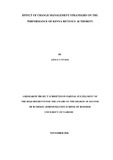| dc.description.abstract | The advent of globalization has brought intense pressure on organizations to fundamentally change how they operate so as to survive in the dynamic business environments and maintain competitiveness. Attempt to carry out changes within an organization results in various challenges faced by the top leadership. Understanding how organizational management deals with these challenges to continue surviving and remain competitive is imperative. Inspired by this concern, this research will therefore, seek to inquire if there are change management practices which organizations going through the change transitions can use to overcome the main challenges to change. Kenya Revenue Authority, which is the subject of this study, undertook changes to its strategic direction, organizational culture, internal process and performance management systems which elicited serious challenges. The Kenya Revenue Authority (KRA) was established by an Act of Parliament, Chapter 469 of the laws of Kenya, which became effective on 1 July 1995. The Authority is charged with the responsibility of collecting revenue on behalf of the Government of Kenya. The Ministry manages the money related area which is key to the improvement of the nation and on which every other division depend for speculation assets. At the end of every financial year i.e. June, the government, through the treasury cabinet secretary, tables estimates in parliament that the Kenya Revenue Authority (KRA) should collect in tax revenues over the next financial year. This is meant to supplement collections by ministries and departments, which are referred to as appropriation-in-aid. The government’s aim to fast track self-sustainability of the economy without external funding relies heavily on the strategies deployed by the tax collection agency to ensure efficiency in revenue collection. The country is also facing additional budgetary needs arising from the management of the devolved system of government as well as a surging wage bill. In the 2013/2014 financial year, the treasury set a target of Ksh 880 billion for the agency, 22% higher than the previous year’s budget. In June 2014, the Kenya Revenue Authority announced that it had surpassed the target set at the onset of the fiscal year by raking in Ksh. 963.7 billion, reflecting a 100% performance in its endeavor and a rise of 16.4 % over the immediate previous year collection. The current target set by the treasury is Ksh. 1.3 trillion that KRA is expected to meet by the end of the 2015/2016 fiscal year. The policies and strategies deployed by the management of the Kenya Revenue Authority during its change management initiative led to improved revenue collection by 22.3% over a period of three years and adoption of the iTax system by over 2 million taxpayers due to the trust and facilitate approach. The results of this study will form a basis for the authority to reference on when conducting change in the future. Other state agencies will be prompted to reassess their change strategies and effectiveness in perspective on their performance. It will change the attitude and approach to change in the public sector. In summary, the study concluded that individuals were encouraged to adapt to the new changes in the organization and the involvement of top management in the change process was essential. Key recommendations of the study include focus on change management practices in a non-autonomous government agency to find out if there are any differences and inclusions of employees in change management initiatives through downward trickling of information. | en_US |



